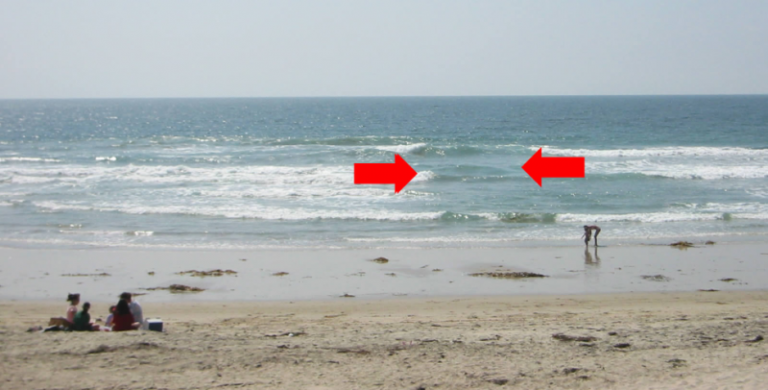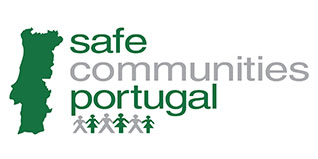A rip current is a narrow, fast-moving channel of water that starts near the beach and extends offshore through the line of breaking waves.
Spotting a rip current can be difficult, and really needs some practice. But when you go to the beach, start off by staying back from the water. Rip currents are easier to see at an elevated position, like a dune line or beach access, and then look for places where waves aren’t breaking, so flat spots in the line of breaking waves. And then also where there’s maybe foam or sediment in the water being transported away from the beach offshore.
Rip currents can occur anywhere you have breaking waves, like large sandy beaches on the open ocean. But they can also occur where you have hard structures, like jetties, or piers, or even rocks jutting out into the ocean.
If you do get caught in a rip current, the best thing you can do is stay calm. It’s not going to pull you underwater, it’s just going to pull you away from shore. Call and wave for help. You want to float, and you don’t want to swim back to shore against the rip current because it will just tire you out. You want to swim out of the rip, parallel to shore, along the beach and then follow breaking waves back to shore at an angle.

The Algarve’s west coast tends to be more hazardous due to the powerful Atlantic Ocean. Surfers and wind-surfers like this coast for its conditions and near-perfect waves, but obviously the wilder water presents a greater risk. Extra caution should be used if you plan on swimming or participating in water sports on the west coast. It is important to monitor weather warnings in these areas.
Algarve’s Benagil caves with new access rules
The Benagil Caves, in the municipality of Lagoa, in the Algarve, have new access rules as of 13th August 2024, which include the prohibition of disembarking and swimming access to their interior.
The new measures, which aim to regulate the traffic of maritime-tourist vessels, private individuals and beach users, both in the water and in the vicinity of the Benagil cave and sinkhole, were published in an official notice on July 30.
It is now forbidden for individuals and companies to disembark or use the sand inside the Benagil cave, access to the caves by swimming or with flotation devices, and the rental of kayaks without a guide in the cave area. There are also limits on the number of boats and kayaks inside the cave, maximum times for visits and a ratio of one guide kayak for every six kayaks with visitors for kayak tours in the area.
There are also provisions for administrative offences (fines), which in the most serious cases can reach up to 216,000 euros, for operators of maritime-tourist vessels who do not comply with the rules set out in the notice.
Located off Benagil beach, the caves are considered to be a relevant natural heritage site and one of the main tourist attractions in the Algarve, which, in the summer, has attracted the interest of more and more visitors, especially by sea.
The notice, which comes into force 10 working days after its publication, resulted from the work developed by the Benagil Caves Working Group, formed in August 2023.
Safe Diving
Why is it so important to pay attention to dives?
Accidents caused by head diving are one of the main causes of spinal cord injuries, especially in places with a depth of less than 150 centimetres.
These accidents can result in head trauma and spinal cord injuries, in particular situations of loss of control and sensitivity of the legs (paraplegia) and loss of movement of the trunk, legs and arms (tetraplegia). In more serious cases, the victim may even die.
Wen is there a higher accident rate? Diving accidents show some seasonality and mostly happen between May and September (85%).
Should diving be avoided? No. It is not necessary to prohibit diving at all. If you want to dive, you must confirm that the safety conditions are in place and take some essential precautions. For example: do not dive into water: unknown depth, low depth (less than twice the diving height); cloudy or with rock; in unlit areas (at night). Always dive with your arms straight out in front of you to protect your head and neck. In unfamiliar places, dive with your “feet” (enter the water with your feet first and not your head) and do not consume alcohol or drugs before diving.
How do injuries occur? Most accidents happen because the water depth at the dive sites was not calculated. Diving injuries generally occur when the head hits the ground, as after the impact the neck receives the weight of the body and produces flexion or extension, which can lead to a fracture or displacement of a cervical vertebra (usually the C5 or C6), and result in spinal cord trauma.
The type of damage caused varies according to the weight, speed and, mainly, the position of the head and spine during the impact. The worst consequence is paralysis and the impossibility of moving the limbs. In other words, the degree of spinal cord injury can end up in a condition of quadriplegia, in which there is paralysis of the arms and legs, or paraplegia, in which the paralysis is only of the legs.
Where do these accidents occur? Diving accidents can happen on beaches, swimming pools or other bathing areas, coastal or river, but they are more common in swimming pools than at sea, with the majority of accidents occurring during leisure activities and not during sports.
What are the recommendations for safe diving?
A poorly calculated dive can have lifelong consequences, so you should bear in mind :
- existence of obstacles around you that you could collide with, namely rocks, boards, people, etc.
- pay attention to existing signage , always stay in a supervised area
- consider the depth , do not dive in shallow water (less than twice your height)
- do not dive into waters you are unfamiliar with or have poor visibility
- do not dive from very high places
- do not dive after consuming alcohol or any other substance that alters cognitive or motor function
- you must dive with your hands in front , so that your head is protected during the dive
- avoid diving backwards or running – the more momentum you give, the deeper the dive



